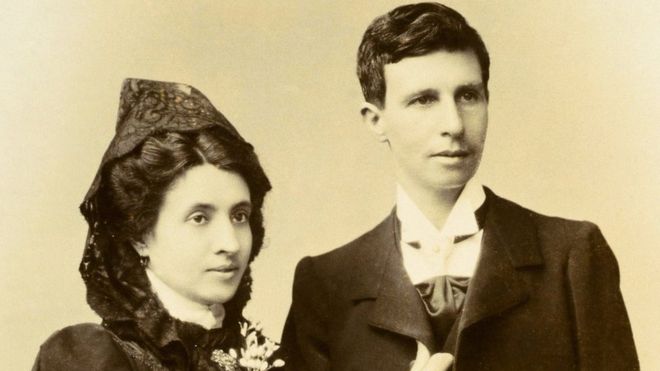In 1901, Marcela and Mário were married at the Catholic Church of Saint George, in the city of La Coruña, northwest Spain. Mário had been baptized on the same day, saying that he was the son of Protestant English parents and that he wanted to convert to Catholicism. The incredible detail of the story is that Mário, in fact, was Elisa Sánchez Loriga, disguised with Marcela's knowledge, so that they could get married in the Church. To this day, this is the only known same-sex marriage in the history of the Spanish Catholic Church. It is also a pioneering case of homosexual union in the world. Now, the couple's story is going to be made into a film. “When I think about these two women and the courage of one of them to pretend to be a man, they were very brave”, says Isabel Coixet, director of the film. Elaborated plot Elisa and Marcela Gracia Ibeas met in the mid-1880s in La Coruña. “Marcela was a student at the teaching school. Elisa had previously studied for the same career and was working at school. It was then that they fell in love”, says writer Narciso Gabriel, author of the book Marcela and Elisa, far beyond men. The couple faced objection from Marcela's family, who sent her to Madrid to stay away from Elisa. But, according to Narciso Gabriel, the two found a way to continue seeing each other. At that time they would have planned the wedding. First, Elisa and Marcela pretended that they had fought and that they were no longer together. Furthermore, Marcela was pregnant by an unidentified man and announced that she would marry Elisa's cousin, called Mário, who was raised in London. So, with a short haircut and dressed in a suit, Elisa pretended to be the boy. Harassment from the press and society After the wedding, Elisa and Marcela had little time to relax. A photo of the couple ended up on the front page of the local newspaper, La Voz de Galicia, with the words: “A wedding without a groom.” The story spread quickly. “The public showed enormous interest in knowing the details of the story, the press competed to publish the exclusive photo. The case had a huge impact not only in Galicia, but also in Madrid and in the press in other countries, such as France, Belgium and Argentina”, said Gabriel. The court, in turn, issued an arrest warrant. Faced with harassment from the press and persecution from the Church and the police, the couple fled to the city of Porto, in Portugal. In Portuguese lands, Elisa started calling herself Pepe. Under the guise of a heterosexual couple, the two lived for two months. During this period, Marcela's daughter was born. However, in August 1901, at the request of the Spanish police, they were arrested and taken to prison in Portugal. According to Gabriel, the case began to gain “coverage in Portugal as spectacular as what happened in Spain”. But, contrary to the Spanish news, the Portuguese press was favorable to the couple. “The press took sides with Marcela and Elisa’s cause, as did part of Portuguese society and some Spanish residents of Porto”, he says. Despite all this commotion, Portugal accepted the couple's extradition, requested by Spain. However, before being sent back, Elisa was cleared of document tampering and Marcela of trying to cover up the crime. Before extradition, however, Marcela and Elisa escaped. This time, heading to Argentina, where, once again, they changed their identities. In Buenos Aires, Marcela changed her name to Carmen; Elisa took the name Maria. New life in Argentina Elisa arrived in Argentina in 1903, two years after her marriage. Shortly afterwards, Marcela arrived, accompanied by her daughter. The lives of young women in Buenos Aires, at first, did not seem to be very different from that of thousands of Galician immigrants who lived in the city. A few months later, however, the story took a new turn. Elisa – who in Argentina had the name Maria – married a man of Danish origin. “The marriage was not happy and ended badly, among other things, because Elisa refused to have sexual relations with her husband”, says Gabriel. The man ended up denouncing Maria, saying that her intentions in marrying him were fraudulent. Where do we hear from? Did Elisa continue living with her Danish husband? Where did Marcela and her daughter go? The outcome of this story is unknown. The clues to the protagonists' lives were lost at this time, says Gabriel. There is only one report from a Mexican newspaper, from 1909, saying that Elisa had committed suicide in the country. Although civil marriage between homosexuals has been legal in Spain for more than a decade, LGBT activists in the country say that there are still echoes of Elisa and Marcela's struggle today. “A law does not cause automatic change in society. Even today there are people who keep their sexuality a secret. Others still get married but don't take the leave they are entitled to after marriage, due to shame or fear of being fired”, says sociologist and activist Inmaculada Mujika Flores. More than a hundred years later, Elisa and Marcela’s “marriage without a man” continues to cause admiration.
in Culture
The story of the lesbians who tricked the Church into getting married and which now inspires a film



